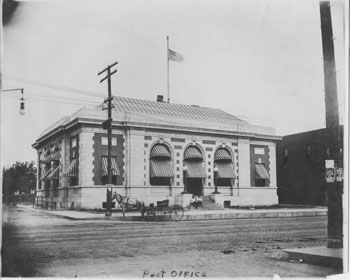
The Greenville Post Office in 1910, shortly after it was built. Note the handbills on the pole to the right. They advertise an entertainment coming to town on July 25, 1910. Photo from the author’s collection.
When Woodrow Wilson took the oath of Office as the President of the United States, he had four close advisors from Texas. “Colonel” Edward M. House would remain a close friend until the Paris Peace talks in 1919. Thomas Watt Gregory, Attorney General; Albert Sidney Burleson, Postmaster General; and David F. Houston, Secretary of Agriculture were cabinet members. All four used their influence for the good of the Texas.
There was no civil service code, no requirements for aptitude in a certain job. Cabinet members held vast opportunities for patronage, especially the Postmaster General. In addition to being responsible for mail delivery, every post office in the country during World War I sold savings certificates and thrift stamps, registered draftees, recruited soldiers and sailors, censored mail for espionage, operated the telephone and telegraph systems as well as assisting citizens with the new income tax forms and laws and doled out jobs.
With the Espionage Act of June 1917, severe penalties were given for obstruction of war effort sent through post offices. Burleson had the power to determine what was obstruction and encouraged local postmasters to send him any “suspicious” materials for his examination. During the first month of the act, fifteen publications were excluded from the mail as “Socialist, unpatriotic, and anti-war.”
Burleson, himself, supported extension of racial segregation in all government offices, opposed wage increases for postal employees, supported increase in cost of second-class mail (newspapers and magazines), fought for government ownership of telephone and telegraph systems, extended parcel post service, and introduced airmail delivery.
With all these responsibilities, the Post Master General also oversaw the construction of new post offices throughout the country. One of those new post office buildings was on Lee Street in Greenville, Texas. The Neo-Classic structure with its Renaissance Revival or Federal “look” was completed in 1910 at a cost of $59,998.35 or roughly $1.5 millions dollars in 2018. The two story plus basement structure was fireproof. James Knox Taylor, US supervising architect in Washington, D. C. designed the building that the construction firm of Fell and Ainsworth of Waco built. Citizens visited the post office for the first time on April 14, 1910 and enjoyed music provided by an African-American string band. Barney Fields was the postmaster.
Originally the site was known as the Federal Building. Within the next sixty years, the federal government expanded on the local level until the building housed the Civil Service Examination room, the IRS, US Army recruiters, Farm Credit Administration, Farm Security Administration, Farmers Home Administration, and Bureau of Animal Industry. In 1930 the Greenville Post Office was expanded to the north or rear of the building, providing not only more office space but also an increase in parking spaces. In June 1970 the Post Office Department moved into a new, more modern and larger facility. The City of Greenville was able to manage the old structure until a local Rotary Club purchased it to revise as a meeting venue. The exterior has had little change. It is a Recorded Texas Historical Landmark and listed on the National Register of Historic Places.
